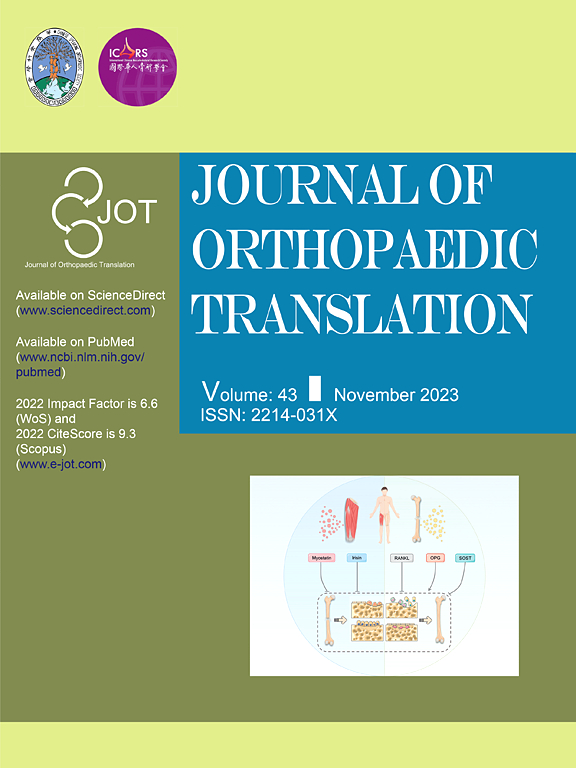Bone organoid construction and evolution
IF 5.9
1区 医学
Q1 ORTHOPEDICS
引用次数: 0
Abstract
Organoids, generated through three-dimensional in vitro culture, are cellular aggregates that accurately mimic the complex microenvironment, cell–cell interactions, and signaling mechanisms of native tissues. These models offer transformative advantages in studying disease mechanisms, drug screening, and personalized medicine. Compared to traditional two-dimensional cell cultures and animal models, organoid systems exhibit higher physiological relevance, effectively mitigating species-specific discrepancies while significantly enhancing clinical translational feasibility. However, current organoid research primarily focuses on soft tissues such as the heart, liver, spleen, lungs, and kidneys, with limited progress in hard tissue organoids, particularly bone organoids. Given the pivotal role of bone tissue in clinical bone repair, disease mechanism elucidation, and drug screening, this field demands further investigation. Based on our previous research, this review introduces a five-stage iterative framework for bone organoid development: 1.0 (physiological model), 2.0 (pathological model), 3.0 (structural model), 4.0 (composite model), and 5.0 (applied model). This paper systematically reviews the technical pathways for bone organoid construction, highlights the core features and scientific value of each model iteration, and explores the current challenges and future directions in this emerging field. The goal is to provide theoretical and technological insights that advance bone organoid research, offering innovative solutions for bone-related disease studies and clinical applications.
The translational potential of this article: This review provides a systematic overview of bone organoid development, highlighting their remarkable role in orthopaedic research and in clinical practice. Through the incorporation of advanced technologies like artificial intelligence and 3D bioprinting, bone organoids provide novel approaches to the development of regenerative medicine and customized orthopaedic treatments.

骨类器官的构建和进化
通过三维体外培养产生的类器官是细胞聚集体,可以准确模拟复杂的微环境、细胞间相互作用和天然组织的信号机制。这些模型为研究疾病机制、药物筛选和个性化医疗提供了变革性的优势。与传统的二维细胞培养和动物模型相比,类器官系统表现出更高的生理相关性,有效地减轻了物种特异性差异,同时显著提高了临床转化的可行性。然而,目前的类器官研究主要集中在心脏、肝脏、脾脏、肺和肾脏等软组织,在硬组织类器官,特别是骨类器官方面进展有限。鉴于骨组织在临床骨修复、疾病机制阐明和药物筛选中的关键作用,这一领域有待进一步研究。基于我们之前的研究,本文介绍了骨类器官发育的五个阶段迭代框架:1.0阶段(生理模型)、2.0阶段(病理模型)、3.0阶段(结构模型)、4.0阶段(复合模型)和5.0阶段(应用模型)。本文系统回顾了骨类器官构建的技术途径,突出了每次模型迭代的核心特征和科学价值,并探讨了这一新兴领域当前面临的挑战和未来的发展方向。目标是提供理论和技术见解,推进骨类器官的研究,为骨相关疾病的研究和临床应用提供创新的解决方案。本文的翻译潜力:本文综述了类骨器官发育的系统概述,强调了它们在骨科研究和临床实践中的重要作用。通过结合人工智能和3D生物打印等先进技术,类骨器官为再生医学和定制骨科治疗的发展提供了新的途径。
本文章由计算机程序翻译,如有差异,请以英文原文为准。
求助全文
约1分钟内获得全文
求助全文
来源期刊

Journal of Orthopaedic Translation
Medicine-Orthopedics and Sports Medicine
CiteScore
11.80
自引率
13.60%
发文量
91
审稿时长
29 days
期刊介绍:
The Journal of Orthopaedic Translation (JOT) is the official peer-reviewed, open access journal of the Chinese Speaking Orthopaedic Society (CSOS) and the International Chinese Musculoskeletal Research Society (ICMRS). It is published quarterly, in January, April, July and October, by Elsevier.
 求助内容:
求助内容: 应助结果提醒方式:
应助结果提醒方式:


